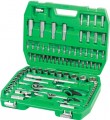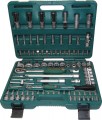Socket heads sizes (6 points)
Working size range of hex sockets (see above) supplied with the kit. This parameter allows you to evaluate how the heads fit the dimensions of the fasteners with which they are planned to be used.
Bit sizes
Varieties of bits (see above) included in the set.
Note that this paragraph specifies not just the size, but also the type of slot for which this or that bit is designed. This type is indicated by a letter index followed by a number describing the size — for example, SL5. Here are the most popular designations found in modern bits:
— SL. Flat bits for straight slot. The size is indicated in millimetres.
— Ph. Classic cross bits. The size is indicated by a conditional number.
— P.Z. Bits for a modified cross slot with improved engagement, have additional edges. The size is indicated by a conditional number.
— TX, T. Torx bits, with six-pointed sprocket tips. The size is indicated by a conditional number.
— H. Hex bits, with hex tips. The size is indicated in millimetres.
If there is more than one bit of a certain type in the set, the number is specified after the designation, for example, PH2x2.
Extension
The type of extension included with the tool kit.
Extensions refer to "intermediate" devices, if necessary, installed between the main tool (like a screwdriver handle, see above) and the working nozzle. As the name implies, they allow you to increase the length of the working part of the tool — for example, to get to hard-to-reach places. Here are the main options for such devices:
—
Hard. Rigid rod extension. It does not give such freedom of action and the ability to get to hard-to-reach places as flexible (see below), but it is considered more reliable, allows you to develop great efforts (often the same as when working without an extension cord) and even allows the use as an improvised lever. Some rigid extensions may also have a crank function (see above).
—
Flexible. An extension in the form of a flexible tube, usually made of a metal spiral. Such an extension, like a universal joint (see above), allows you to position the nozzle at an angle to the axis of rotation of the main tool — while the range of such angles is much wider (in some cases they can reach 180 °), and the long length and high mobility of the device are even more expands freedom of action. The disadvantage of flexible extensions is less suitability for work with greater efforts than the rigid ones described above.
— Rigid/flexible. This option is indicated for sets equipped with both types of
...extensions described above. This makes it possible to choose an option depending on the specific situation.
If there are several extensions of the same type in the kit, they, usually, differ in the size of the attachment (see "Landing square").Dimensions
The dimensions of the entire set, namely the case, lodgment, cassette, etc. storage accessory (see paragraph above) with tools installed inside. Allows you to understand how much space the model will occupy and whether it can be placed in a complete set in one place or another.
Weight
The total weight of the tool kit. Indicated with a case, stand or other storage/transportation device (see Tool Storage). First of all, you should pay attention to this parameter if you plan to often carry the kit over long distances — the lighter the weight, the easier it will be to do. At the same time, extensive sets inevitably turn out to be weighty.

